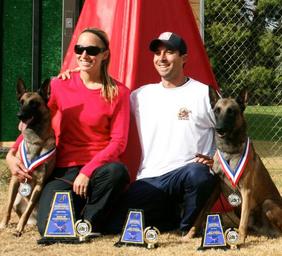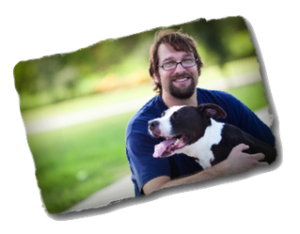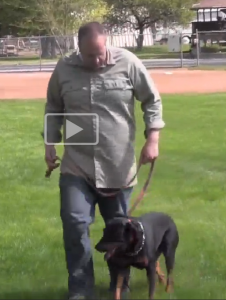 Create Environments For Dog Training Success
Create Environments For Dog Training Success
I’ve come to realize, over the years, that you are far better off proactively creating environments where your dog WANTS to be obedient and problem free than you are trying to address dog problems one by one as they come up.
This podcast goes into checklist detail on what you can do to create the right environment for your dog.
The following is an abbreviated transcript of the call.
I once had a client several years ago who had beat cancer. When he got the diagnosis from his doctor he decided he didn’t want the chemotherapy and instead decided to treat himself.
He told me that cancerous cells can’t exist in a body that is pure, or something like that, I can’t recall 100%. So he decided that he would only drink pure and balanced water, organic foods with no pesticides, nothing processed, etc.
The result? His cancer went away.
Now, I’m not a doctor, I’m not a natural healer and I have no way of knowing what went on with his body.
Nor am I going to talk much more about the subject because I know that people get very strong opinions on both sides of this argument on how to treat cancer and that isn’t the purpose of what I’m talking about today.
What I wanted to get at with this example is that what he said made sense to me. That if you create a body that is running on pure fuel and doesn’t have toxins and contaminants then a cancer couldn’t live there. Whether that’s true or not it did make sense.
I also was able to relate it, however, to what goes on with our dogs. Let’s look at bad behavior…I’m talking aggression, destruction, hyperactivity, getting on counters, etc. as the cancer that plagues dog/owner relationships.
My experience has been that if the right environment is created for this creature that we invite into our homes, it becomes so much more difficult for that cancer to get a foothold.
An example. With our Utah dog training business, CommuniCanine, we have a service called our Boot Camp. That’s where we take our client’s dogs into the homes of our trainers. I can tell you, and many of our clients have a hard time believing it, but by day two, and frequently within the first half hour of the dog being OUT of their owners home and into our home the dog is COMPLETELY different.
I’m not exaggerating. In most cases the same dog who was trying to attack everyone, peeing all over the house, jumping on every guest, barking excessively at every noise, etc. is doing NONE of those things by day two. We typically keep the dog for 3 weeks because we need to proof the change, teach a lot of skills, and get lots of repetition but it never fails that we can see dramatic change almost immediately.
The ‘why’ is because the dog is coming from a toxic environment. Now, I don’t mean that in an offensive way. But the dog is coming from an environment where it was allowed to do awful things into a new environment where that behavior is not tolerated.
So when we do boot camps our challenge isn’t to get the dog to stop those behaviors or even get the dog trained. Our challenge is to take a newly trained dog and help the owners create an environment where that training can be maintained. Essentially, we’re taking this newly created, beautiful snowflake with all it’s complexity into an owner’s home and trying to teach them how to not blast the heater. That is our challenge as dog trainers.
I’m not saying creating the right environment is the only thing that needs to be done for our dogs but I’m becoming more and more convinced as the years go on that we need to be more proactive than reactive when it comes to our dog’s behavior. Instead of looking at ‘Crap, my dog is doing this, that, and the other’ I think we need to be creating an environment that is more prone to success for our dogs.
That is the purposed of today’s call.
I’m going to present a number of ideas to you. I’m going to do them in checklist form. I want you to understand, though, that not all of these are hard and fast rules. I’m simply going to present EVERYTHING that we’ve worked on with clients that has had some benefit in creating the right environment. Not all of these things need to be done with every dog. But I want you to have a cache of information so you can start experimenting and see what works best for your dog and your situation.
- Free affection. There’s nothing wrong with giving your dog attention and affection because you love the big lug. The problem comes when dogs come to seek that attention and affection all the time. In a literal sense it becomes like a drug that when they can’t have it, due to you being busy with other tasks or you being out of the home. In such case we see a lot of destruction and anxiety. The dog is seeking his next fix and it comes out in the form of eating up your stuff, pacing, barking like a maniac etc. Try to tie a lot of your affection to tasks. If you want to give your dog some love have him do something first; even as simple as sitting, lying down, recall, etc. When your dog comes up to you and demands attention have him lie down a few feet away from you. Not as a punishment or a time out but simply to help him learn to relax on his own, at which point you reward that state of mind by allowing him up and giving affection.
- Have your dog wait at doors. If your dog goes out the door first does that mean he’s staging a coup against your governance? Not usually. But I like to teach a lot of what I call ‘checks and balances’. Little behaviors that are super easy that can become habitual that are little reminders throughout the day about calmness, structure, respect of space, etc. Along with other checks and balance I like:
- Sitting before eating.
- Sitting before putting a leash on
- Stopping when you stop on walks
- Use a stabilized approach to training. Dog training has gone the route of child rearing. Years ago, my opinion is that the culture of child rearing was too harsh. Smacking the heck out of your kid with a belt is not my idea of good parenting. It seems like in order to compensate that society has done a complete U-Turn and now looking cross-eyed at your kids will get you a visit from social services. It seems like many of us parents lament the passing of balance and stability. The same is true with our dogs. Many decades ago training was too harsh. But now it’s completely done a 180 where you can’t ever use anything other than a treat and a firm tone. Any sort of training collar is taboo and heaven help you for giving a leash correction or e-collar. Folks, you can have your cake and eat it too. You can use corrections from leashes and collars that are humane. Corrections done well aren’t designed to hurt the dog, they’re designed to get the dog’s attention, move the dog into a different state of mind, discourage certain behaviors, etc. You can accomplish a great deal without hurting your dog.I say this because many dog owners that I meet see a disconnect. When I talk about creating an environment of calmness, respect, etc. they get that and want it. But then the other trainer is telling them that if the dog jumps they have to turn their back, if the dog bites they have to say ‘ouch’ and give the dog a toy and can never correct the dog. This new style of training is absolutely ridiculous. I study it and learn from it because I like to know how to better motivate my dogs with positive principles so I’m not saying it’s all bad. But any time you find a spectrum and you set yourself up on one of the spectrum I believe you’re doomed for failure. In this case if the spectrum is one side being zero corrections and the other side being all corrections and no motivation they’re both barking up the wrong tree. You need stability and balance. So when you are looking to create this environment I’ve been speaking of be firm but fair. Give humane corrections for misbehaviors. Dogs are physical learners and using a correction for misbehavior is warranted, humane, fair, and more. Make sure your corrections are not emotion based but are simple reminders of behavior you want.
- Be careful how you leave and come home. You can be creating an environment of anxiety by placing too much importance on your comings and goings.
- Do a few solid down stays per day. We often like to do them during dinner time and during our wind down time while we watch TV at night. This is something I’ve always done because it seemed to help but it wasn’t until I did an interview with Chad Mackin that I really nailed down the ‘why’. Many dogs get over-adrenalized meaning their adrenaline spikes and they use that chemical influx in their systems to make choices. By doing down stays throughout the day the dog learns to self-regulate that adrenaline and it leads to an environment that is calmer and more conducive to harmony vs. being nutty.
- Be careful to not inadvertently reward negative behaviors. For example, I’m not a fan of people training their dogs to use a bell to go potty. Many dogs abuse it and it becomes a little butler bell for the dog to summon their owner every time they have a whim to go chase a squirrel in the back yard. The same is true for the dog who brings the ball in his mouth to the owner and nudges him until the owner throws it. The owner thinks the dog looks so cute there with his puppy-dog eyes and ball hanging out of his mouth but often, if the dog could talk, he’s be saying ‘Hey, you. Yeah you. Shut up, stop what you’re doing and pay attention to me.’ And what does the owner do? He acquiesces and does what the dog wants. There are a lot of behaviors like this. Dogs whining until you pet them. Dogs vocalizing to demand to be allowed on furniture. Things like this are ways that your environment around the home gets out of control.
- Do teach kids how to interact with dogs. Our kids, which are wild and crazy kids like any others, typically ask to go play with the dogs. They generally don’t pay them too much attention around the house. We’ve taught them to leave the dogs alone when they are eating, chewing a toy, or sleeping. This is by design. Contrast this with dogs who live in constant anxiety because kids pester them, bother them, follow them around, etc. I’ve heard lots of excuses from parents that the children are young and can’t be taught just yet. While I understand the limitations of teaching a young child I also know that even the youngest kids who are just walking can be taught to leave the dogs alone. Does that mean that dogs and kids shouldn’t hang out and be friends? Nope. It does mean, though, that I, as the parent, want to be the gateway for that relationship. Dogs have a mentality of a 2, 3, 4, or 5 year old child. I said mentality, not intelligence level. I can’t very well expect that I can leave my two kids alone, who are 7 and 5 years old, and have them work out their relationship in a way that is acceptable to me. Why would I expect to do that with my dogs and my kids. I’m the gateway for my children to learn to respect each other, not hit, bite, punch, or slap one another. I need to be that same gateway for my dogs and kids.
- Don’t let your dog be the first to greet your guests. It’s your job to greet guests and your dog’s job to greet them when you’ve allowed it. Make sure your dog does a down stay when someone comes over and only greets your guest when you let the dog up.
- Work on high level obedience and ‘core behaviors’.















Follow Us!
By FRESHEC electronic cigarette